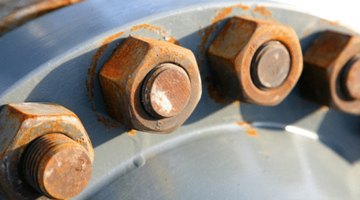How to Remove Rust From a Bolt
Similar to any metallic object, bolts are susceptible to rust. Once rust has set in, it will ruthlessly attack unprotected metal and render it practically useless if steps aren’t taken to reverse the corrosion process. The threads on a bolt are especially vulnerable to the damage caused by rust.

In fact, severely rusted threads will make the bolt unusable. Fortunately, it is possible to remove rust from bolts. All that’s required to eliminate the corrosion are some basic supplies and time.
Things You Will Need
- Small wire brush
- Commercial rust cleaner
- Abrasive pad for an electric or cordless drill
- Plastic, sealable container
- Vinegar
- Fine-grit sandpaper, 120-grit or higher
For Moderate to Severe Rust
-
Brush as much of the heavier corrosion off of the bolt as possible using a small wire brush. Brush lightly between the threads so as to avoid damaging them.
-
Apply a commercial rust cleaner to the bolt. Rust cleaners are available at most hardware stores, as well as automotive supply/parts stores. Depending on the type of rust cleaner you purchase, you may spray the cleaner onto the bolt or submerge the bolt in a liquid.
-
Allow the rust cleaner to soak on the rusted bolt. Read the directions on your particular brand of rust cleaner for the specific time you should allow the bolt to soak. Wipe away any leftover residue on the bolt using a rag.
-
Attach an abrasive pad to an electric or cordless drill. The abrasive pad is similar to a wire wheel, a tool frequently used to remove rust or other foreign material. An abrasive pad, however, is slightly abrasive, which means it is less likely to damage the threads on the bolt. Pass the pad over the bolt to buff away any remaining rust.
For Light Rust
-
Place the rusty bolt in a plastic, sealable container. Add enough pure vinegar to the container to fully submerge the bolt. Seal the container and shake several times.
-
Allow the bolt to soak in the vinegar for approximately 24 hours. Vinegar contains a mild acid that dissolves rust. After a full day has elapsed, remove the bolt from the vinegar.
-
Use a fine sandpaper, 120-grit or higher, to manually sand any remaining rust from the bolt. Continue sanding until you’re satisfied that the bolt is rust-free.
The Drip Cap
- Similar to any metallic object, bolts are susceptible to rust.
- Once rust has set in, it will ruthlessly attack unprotected metal and render it practically useless if steps aren’t taken to reverse the corrosion process.
- An abrasive pad, however, is slightly abrasive, which means it is less likely to damage the threads on the bolt.
- Seal the container and shake several times.
- Vinegar contains a mild acid that dissolves rust.
- Use a fine sandpaper, 120-grit or higher, to manually sand any remaining rust from the bolt.
References
Writer Bio
Arthur Barnhouse has written numerous short stories, contributed content to various websites and was an invited speaker at a university symposium on creative writing. He began writing in 2002 and holds a Bachelor of Arts in English literature from the University of Pittsburgh. Barnhouse has driven across the United States numerous times and draws upon his travel experiences in his writing.
Photo Credits
- Jupiterimages/Photos.com/Getty Images
- Jupiterimages/Photos.com/Getty Images
More Articles



